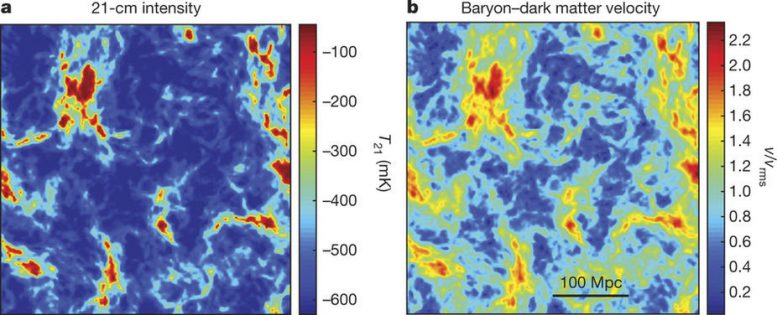
a, The 21-cm-transition brightness temperature T21 (in millikelvin) in a two-dimensional slice (thickness of 3 Mpc) of a simulated volume of the Universe with sides of 384 Mpc (all lengths co-moving). We consider z = 17 (ν = 78.9 MHz), where this model (with σ1 = 8 × 10−20 cm2 and dark-matter particle mass mχ = 0.3 GeV) reaches its maximum global 21-cm absorption depth of −504 mK (roughly matching the most likely observed value5). This astrophysical model is based on a semi-numerical simulation15 (see Methods). The spatial 21-cm-signal pattern is determined by the baryon–dark matter relative velocity left over from early cosmic evolution before recombination. b, Distribution of the baryon–dark matter relative velocity (in the same simulated volume as that shown in a, assuming adiabatic initial density fluctuations), normalized by its r.m.s. value of 29 km s−1 at 1 + z = 1,010. Credit: Rennan Barkana, Nature, doi:10.1038/nature25791
A team of astronomers led by Prof. Judd Bowman of Arizona State University unexpectedly stumbled upon “dark matter,” the most mysterious building block of outer space, while attempting to detect the earliest stars in the universe through radio wave signals, according to a study published this week in the journal Nature.
The idea that these signals implicate dark matter is based on a second Nature paper published this week, by Prof. Rennan Barkana of Tel Aviv University, which suggests that the signal is proof of interactions between normal matter and dark matter in the early universe. According to Prof. Barkana, the discovery offers the first direct proof that dark matter exists and that it is composed of low-mass particles.
The signal, recorded by a novel radio telescope called EDGES, dates to 180 million years after the Big Bang.
What the universe is made of
“Dark matter is the key to unlocking the mystery of what the universe is made of,” says Prof. Barkana, Head of the Department of Astrophysics at TAU’s School of Physics and Astronomy. “We know quite a bit about the chemical elements that make up the earth, the sun, and other stars, but most of the matter in the universe is invisible and known as ‘dark matter.’ The existence of dark matter is inferred from its strong gravity, but we have no idea what kind of substance it is. Hence, dark matter remains one of the greatest mysteries in physics.
“To solve it, we must travel back in time. Astronomers can see back in time, since it takes light time to reach us. We see the sun as it was eight minutes ago, while the immensely distant first stars in the universe appear to us on earth as they were billions of years in the past.”
Prof. Bowman and colleagues reported the detection of a radio wave signal at a frequency of 78 megahertz. The width of the observed profile is largely consistent with expectations, but they also found it had a larger amplitude (corresponding to deeper absorption) than predicted, indicating that the primordial gas was colder than expected.
Prof. Barkana suggests that the gas cooled through the interaction of hydrogen with cold, dark matter.
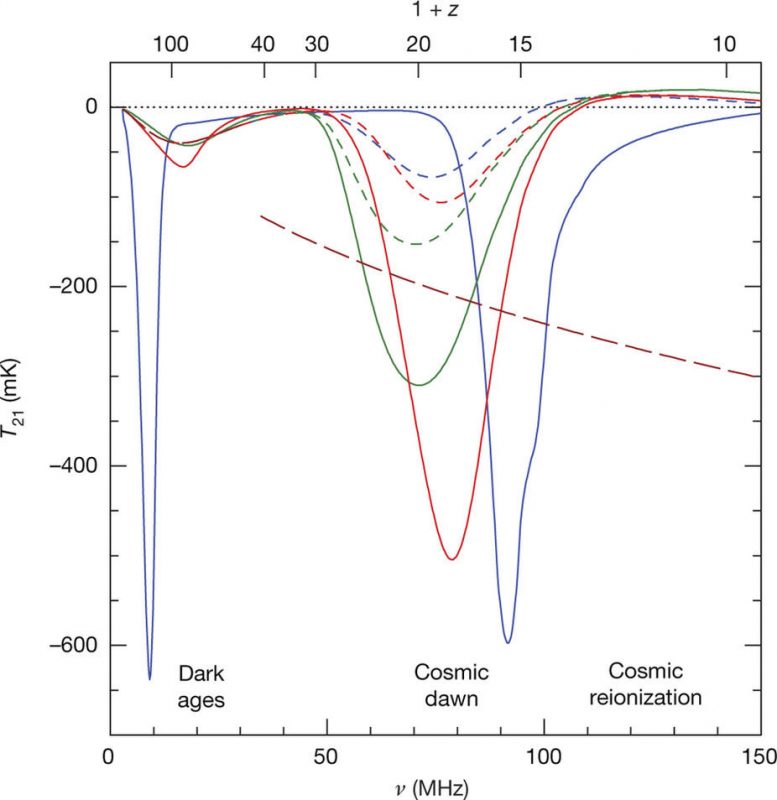
The globally averaged 21-cm brightness temperature T21 (in millikelvin) is shown at an observed frequency ν (in megahertz), with the corresponding value of 1 + z displayed at the top. We chart some of the space of possible 21-cm signals (see Methods for a discussion on their shapes) using three models (solid curves), with: σ1 = 8 × 10−20 cm2 and mχ = 0.3 GeV (red; roughly matching the most likely observed value5 of the peak absorption); σ1 = 3 × 10−19 cm2 and mχ = 2 GeV (green); and σ1 = 1 × 10−18 cm2 and mχ = 0.01 GeV (blue). The astrophysical parameters assumed by these models are given in Methods. The corresponding 21-cm signals in the absence of baryon–dark matter scattering are shown as short-dashed curves. Also shown for comparison (brown long-dashed line) is the standard prediction for future dark ages measurements assuming no baryon–dark matter scattering for ν < 33 MHz (matches all the short-dashed curves in this range) and the lowest global 21-cm signal at each redshift that is possible with no baryon–dark matter scattering, regardless of the astrophysical parameters used (for ν > 33 MHz). Credit: Rennan Barkana, Nature, doi:10.1038/nature25791
“Tuning in” to the early universe
“I realized that this surprising signal indicates the presence of two actors: the first stars, and dark matter,” says Prof. Barkana. “The first stars in the universe turned on the radio signal, while the dark matter collided with the ordinary matter and cooled it down. Extra-cold material naturally explains the strong radio signal.”
Physicists expected that any such dark matter particles would be heavy, but the discovery indicates low-mass particles. Based on the radio signal, Prof. Barkana argues that the dark-matter particle is no heavier than several proton masses. “This insight alone has the potential to reorient the search for dark matter,” says Prof. Barkana.
Once stars formed in the early universe, their light was predicted to have penetrated the primordial hydrogen gas, altering its internal structure. This would cause the hydrogen gas to absorb photons from the cosmic microwave background, at the specific wavelength of 21 cm (8 in), imprinting a signature in the radio spectrum that should be observable today at radio frequencies below 200 megahertz. The observation matches this prediction except for the unexpected depth of the absorption.
Prof. Barkana predicts that the dark matter produced a very specific pattern of radio waves that can be detected with a large array of radio antennas. One such array is the SKA, the largest radio telescope in the world, now under construction. “Such an observation with the SKA would confirm that the first stars indeed revealed dark matter,” concludes Prof. Barkana.
Reference: “Possible interaction between baryons and dark-matter particles revealed by the first stars” by Rennan Barkana, 1 March 2018, Nature.
DOI: 10.1038/nature25791

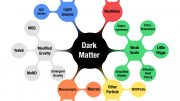
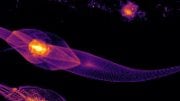

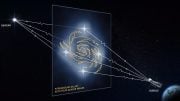
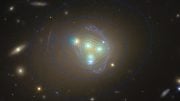
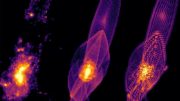
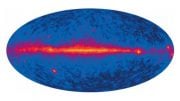
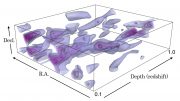
Be the first to comment on "First Stars Reveal Possible Interaction Between Baryons and Dark-Matter Particles"